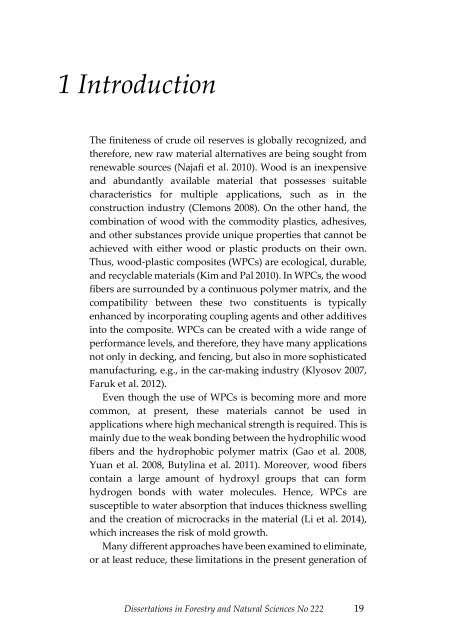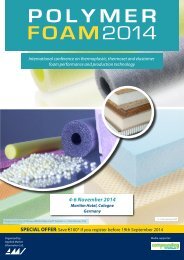Dissertations in Forestry and Natural Sciences
24lYKFN
24lYKFN
You also want an ePaper? Increase the reach of your titles
YUMPU automatically turns print PDFs into web optimized ePapers that Google loves.
1 Introduction<br />
The f<strong>in</strong>iteness of crude oil reserves is globally recognized, <strong>and</strong><br />
therefore, new raw material alternatives are be<strong>in</strong>g sought from<br />
renewable sources (Najafi et al. 2010). Wood is an <strong>in</strong>expensive<br />
<strong>and</strong> abundantly available material that possesses suitable<br />
characteristics for multiple applications, such as <strong>in</strong> the<br />
construction <strong>in</strong>dustry (Clemons 2008). On the other h<strong>and</strong>, the<br />
comb<strong>in</strong>ation of wood with the commodity plastics, adhesives,<br />
<strong>and</strong> other substances provide unique properties that cannot be<br />
achieved with either wood or plastic products on their own.<br />
Thus, wood-plastic composites (WPCs) are ecological, durable,<br />
<strong>and</strong> recyclable materials (Kim <strong>and</strong> Pal 2010). In WPCs, the wood<br />
fibers are surrounded by a cont<strong>in</strong>uous polymer matrix, <strong>and</strong> the<br />
compatibility between these two constituents is typically<br />
enhanced by <strong>in</strong>corporat<strong>in</strong>g coupl<strong>in</strong>g agents <strong>and</strong> other additives<br />
<strong>in</strong>to the composite. WPCs can be created with a wide range of<br />
performance levels, <strong>and</strong> therefore, they have many applications<br />
not only <strong>in</strong> deck<strong>in</strong>g, <strong>and</strong> fenc<strong>in</strong>g, but also <strong>in</strong> more sophisticated<br />
manufactur<strong>in</strong>g, e.g., <strong>in</strong> the car-mak<strong>in</strong>g <strong>in</strong>dustry (Klyosov 2007,<br />
Faruk et al. 2012).<br />
Even though the use of WPCs is becom<strong>in</strong>g more <strong>and</strong> more<br />
common, at present, these materials cannot be used <strong>in</strong><br />
applications where high mechanical strength is required. This is<br />
ma<strong>in</strong>ly due to the weak bond<strong>in</strong>g between the hydrophilic wood<br />
fibers <strong>and</strong> the hydrophobic polymer matrix (Gao et al. 2008,<br />
Yuan et al. 2008, Butyl<strong>in</strong>a et al. 2011). Moreover, wood fibers<br />
conta<strong>in</strong> a large amount of hydroxyl groups that can form<br />
hydrogen bonds with water molecules. Hence, WPCs are<br />
susceptible to water absorption that <strong>in</strong>duces thickness swell<strong>in</strong>g<br />
<strong>and</strong> the creation of microcracks <strong>in</strong> the material (Li et al. 2014),<br />
which <strong>in</strong>creases the risk of mold growth.<br />
Many different approaches have been exam<strong>in</strong>ed to elim<strong>in</strong>ate,<br />
or at least reduce, these limitations <strong>in</strong> the present generation of<br />
<strong>Dissertations</strong> <strong>in</strong> <strong>Forestry</strong> <strong>and</strong> <strong>Natural</strong> <strong>Sciences</strong> No 222 19



